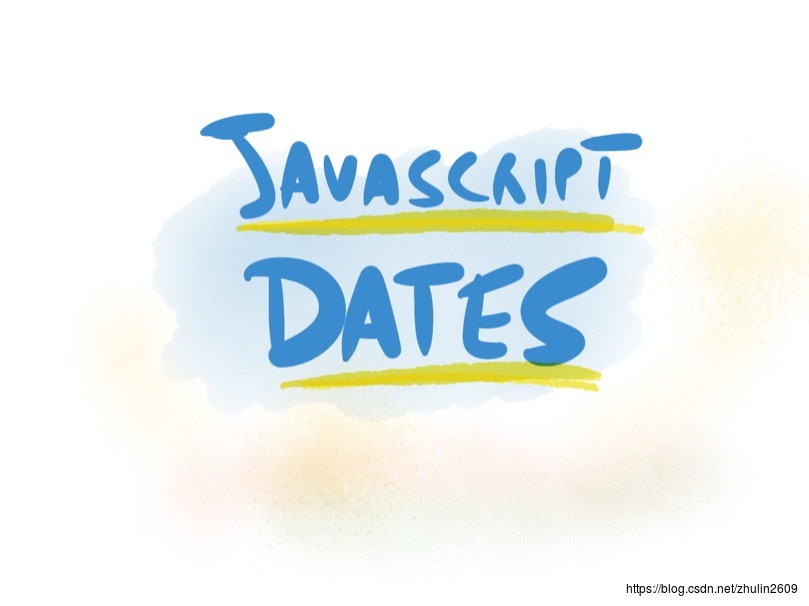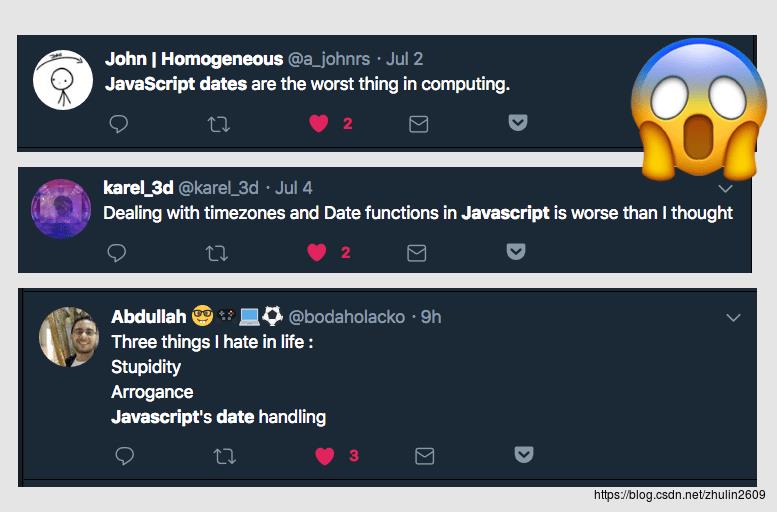JavaScript Dates 权威指南译
Posted zhulin2609
tags:
篇首语:本文由小常识网(cha138.com)小编为大家整理,主要介绍了JavaScript Dates 权威指南译相关的知识,希望对你有一定的参考价值。
在javascript中操作日期可能非常复杂,让我们来学习使用所有相关的技巧吧!原文链接:https://flaviocopes.com/javascript-dates/

介绍
操作日期可能非常复杂,可能无论怎样操作,都会有开发者感到痛苦。

JavaScript通过一个强大的对象: Date来给我们提供日期处理函数。
这篇文章不会去讨论Moment.js,我相信这是最好的用来处理日期的库,你应该总是用它来处理日期。、
Date对象
一个Date对象实例代表一个单一的时间点。尽管它叫Date,但它其实是用来处理time的。
初始化Date对象
我们可以通过下面的代码来初始化一个Date对象:
new Date()它创建了一个Date对象来指向当前时刻。
在内部,dates表达的是从1970年1月1日零点至今的毫秒数。这个日期很重要,因为就计算机而言,那是一切开始的地方。
你可能对UNIX时间戳更熟悉:代表这个著名的时间点(1970年1月1日零点)至今所过的秒数。
重要:UNIX时间戳用秒表示,JavaScript 日期用毫秒表示
如果我们已经有了一个UNIX时间戳,我们可以通过下面代码来实例化一个JavaScript日期对象:
const timestamp = 1530826365
new Date(timestamp * 1000)如果我们传0,我们会得到一个表示1970年1月1日0点(UTC)的Date对象:
new Date(0)如果我们更想传入字符串,那么Date对象会用parse方法来决定我们传入的日期,例如:
new Date('2018-07-22')
new Date('2018-07') //July 1st 2018, 00:00:00
new Date('2018') //Jan 1st 2018, 00:00:00
new Date('07/22/2018')
new Date('2018/07/22')
new Date('2018/7/22')
new Date('July 22, 2018')
new Date('July 22, 2018 07:22:13')
new Date('2018-07-22 07:22:13')
new Date('2018-07-22T07:22:13')
new Date('25 March 2018')
new Date('25 Mar 2018')
new Date('25 March, 2018')
new Date('March 25, 2018')
new Date('March 25 2018')
new Date('March 2018') //Mar 1st 2018, 00:00:00
new Date('2018 March') //Mar 1st 2018, 00:00:00
new Date('2018 MARCH') //Mar 1st 2018, 00:00:00
new Date('2018 march') //Mar 1st 2018, 00:00:00这里的传参非常灵活,你可以添加或者省略月份或日期前面的0。
要非常小心的处理日期和月份的位置,因为你很可能把二者的位置搞混。
你还可以使用Date.parse:
Date.parse('2018-07-22')
Date.parse('2018-07') //July 1st 2018, 00:00:00
Date.parse('2018') //Jan 1st 2018, 00:00:00
Date.parse('07/22/2018')
Date.parse('2018/07/22')
Date.parse('2018/7/22')
Date.parse('July 22, 2018')
Date.parse('July 22, 2018 07:22:13')
Date.parse('2018-07-22 07:22:13')
Date.parse('2018-07-22T07:22:13')Date.parse会返回毫秒单位的时间戳,而不是Date对象。
你也可以按顺序分块设置:年份、月份(从0开始)、日期、小时、分钟、秒和毫秒
new Date(2018, 6, 22, 7, 22, 13, 0)
new Date(2018, 6, 22)至少要传三个参数,但是大多数JavaScript引擎也能接受少于3个的传数
new Date(2018, 6) //Sun Jul 01 2018 00:00:00 GMT+0200 (Central European Summer Time)
new Date(2018) //Thu Jan 01 1970 01:00:02 GMT+0100 (Central European Standard Time)上面所有这些例子,都是相对于你计算机所在的时区的时间。这意味着,两台不同的电脑会根据同一个Date对象输出不同的值。
JavaScript在没有任何关于时区的信息时,会将日期当做UTC,并且会自动的将时间转换为电脑当前所在的时区。
总结一下,你可以通过4中方法来创建一个新的Date对象:
- 不传参数,创建一个Date对象来表示当前时间
- 传一个表示从格林威治时间1970年1月1日0点至今的毫秒数
- 传一个表示日期的字符串
- 传一个包含日期各个部分的参数集合
时区
初始化一个日期时你可以把时区传进去,这样date对象就不会假设时区是UTC,然后将其转换成你本地的时区。
你可以按如下形式将指定的时区传入:
new Date('July 22, 2018 07:22:13 +0700')
new Date('July 22, 2018 07:22:13 (CET)')如果你在括号中传入了一个错误的时区,JavaScript会选择默认的UTC时区。
如果你指定了一个错误的数字类型的时区,JavaScript会抛出Invalid Date的错误。
日期的转换和格式化
给定一个Date对象,用非常多的方法将日期转换成字符串:
const date = new Date('July 22, 2018 07:22:13')
date.toString() // "Sun Jul 22 2018 07:22:13 GMT+0200 (Central European Summer Time)"
date.toTimeString() //"07:22:13 GMT+0200 (Central European Summer Time)"
date.toUTCString() //"Sun, 22 Jul 2018 05:22:13 GMT"
date.toDateString() //"Sun Jul 22 2018"
date.toISOString() //"2018-07-22T05:22:13.000Z" (ISO 8601 format)
date.toLocaleString() //"22/07/2018, 07:22:13"
date.toLocaleTimeString() //"07:22:13"
date.getTime() //1532236933000
date.getTime() //1532236933000Date对象的读接口
Date对象提供了好几种方法来获取具体的值,但是都基于电脑所在当前的时区:
const date = new Date('July 22, 2018 07:22:13')
date.getDate() //22
date.getDay() //0 (0 means sunday, 1 means monday..)
date.getFullYear() //2018
date.getMonth() //6 (starts from 0)
date.getHours() //7
date.getMinutes() //22
date.getSeconds() //13
date.getMilliseconds() //0 (not specified)
date.getTime() //1532236933000
date.getTimezoneOffset() //-120 (will vary depending on where you are and when you check - this is CET during the summer). Returns the timezone difference expressed in minutes这些方法都有对应的UTC等价版本,这些UTC方法返回的是UTC格式的值,而不是基于当前时区的。
date.getUTCDate() //22
date.getUTCDay() //0 (0 means sunday, 1 means monday..)
date.getUTCFullYear() //2018
date.getUTCMonth() //6 (starts from 0)
date.getUTCHours() //5 (not 7 like above)
date.getUTCMinutes() //22
date.getUTCSeconds() //13
date.getUTCMilliseconds() //0 (not specified)编辑一个日期
Date对象提供了一些方法来编辑它的值
const date = new Date('July 22, 2018 07:22:13')
date.setDate(newValue)
date.setDay(newValue)
date.setFullYear(newValue) //note: avoid setYear(), it's deprecated
date.setMonth(newValue)
date.setHours(newValue)
date.setMinutes(newValue)
date.setSeconds(newValue)
date.setMilliseconds(newValue)
date.setTime(newValue)
date.setTimezoneOffset(newValue)setDay 和 setMonth 方法的起始值都是0, 例如三月对应的月份值是2。
一个有趣的事实是,这些值是可以“进位(overlap)”的。举个例子,如果你使用date.setHours(48),它将直接增加对应的天数。
不可不知:你可以给setHours设置不知一个参数,来设置分、秒、毫秒:setHours(0, 0, 0, 0),效果跟setMinutes和setSeconds是一样的。
像get方法一样,set方法也有对应的UTC版本:
const date = new Date('July 22, 2018 07:22:13')
date.setUTCDate(newalue)
date.setUTCDay(newValue)
date.setUTCFullYear(newValue)
date.setUTCMonth(newValue)
date.setUTCHours(newValue)
date.setUTCMinutes(newValue)
date.setUTCSeconds(newValue)
date.setUTCMilliseconds(newValue)获取当前的时间戳
如果你想获取毫秒单位的当前时间戳,你可以使用简写:
Date.now()来取代
new Date().getTime()JavaScript希望努力做好的部分
请注意,如果你使用的天数溢出了一个自然月,这不会报错,日期会进位到下个月:
new Date(2018, 6, 40) //Thu Aug 09 2018 00:00:00 GMT+0200 (Central European Summer Time)这个规则对月份、小时、分钟、秒、毫秒同样生效。
本地化日期
现代浏览器(除了UC浏览器)已经很好的支持国际化API,来让你很好的转换时间格式。
可以使用Intl对象暴露的接口来本地化数字、字符串和货币。
我们需要关注的是Intl.DateTimeFormat()这个接口。
现在来看看怎么使用它。
根据电脑默认的地区来格式化日期:
// "12/22/2017"
const date = new Date('July 22, 2018 07:22:13')
new Intl.DateTimeFormat().format(date) //"22/07/2018" in my locale指定不同的地区来格式化日期:
new Intl.DateTimeFormat('en-US').format(date) //"7/22/2018"Intl.DateTimeFormat提供了一个可选的参数供定制输出的格式,包括展示小时、分钟和秒数:
const options =
year: 'numeric',
month: 'numeric',
day: 'numeric',
hour: 'numeric',
minute: 'numeric',
second: 'numeric'
new Intl.DateTimeFormat('en-US', options).format(date) //"7/22/2018, 7:22:13 AM"
new Intl.DateTimeFormat('it-IT', options2).format(date) //"22/7/2018, 07:22:13"比较两个日期
你可以使用Date.getTime()来计算两个日期的差值:
const date1 = new Date('July 10, 2018 07:22:13')
const date2 = new Date('July 22, 2018 07:22:13')
const diff = date2.getTime() - date1.getTime() //difference in milliseconds也可以用这个方法来判断两个日期是否相等:
const date1 = new Date('July 10, 2018 07:22:13')
const date2 = new Date('July 10, 2018 07:22:13')
if (date2.getTime() === date1.getTime())
//dates are equal
记住getTime()返回的是毫秒值,所以在比较的时候需要把时间因素考虑进去。July 10, 2018 07:22:13并不等于July 10, 2018。在这个例子里,你可以使用setHours(0, 0, 0, 0)来重置时间。
以上是关于JavaScript Dates 权威指南译的主要内容,如果未能解决你的问题,请参考以下文章